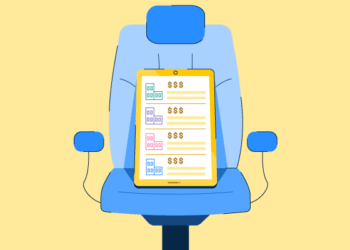Even if you’re the very best coach in the world, you won’t get clients if potential clients who want your solution:
- Don’t know you exist
- Don’t realize (or believe) that you can deliver value to them
- Don’t know how to contact you
These are the reasons potential clients aren’t reaching out to you right now.
The good news is that if you can solve each of those problems, you’ll get coaching clients.
In this post, we’ll demystify the process of acquiring coaching clients.
You’ll learn how to connect with your ideal clients, build a relationship with them, and provide value that’s so helpful they reach out to you for coaching services.
Want to be a high-earning Copy Creator instead of a struggling content creator?
Our CEO will work with you 1v1 to strengthen your personal brand, create better content, master online networking, and get a lot more clients. Plus, it’ll cost you about 70% less typical coaching programs.
Step 1: Define Who Is (And Is NOT) Your Ideal Coaching Client
If you’re going to have a doctor perform brain surgery on you, would you hire a brain surgeon or a general doctor?
Even if the brain surgeon costs significantly more, you’ll still probably select the brain surgeon.
Why? You assume that because they’re a specialist in your problems, they’ll probably do a better job.
The same is true for coaching.
Coaching clients want to hire specialists, not generalists.
Therefore, the first step is becoming very clear about the specific problems you solve and the type of person you help.
Start by defining two things:
- The Problem: What specific pain or challenge do your clients have that you can solve? For example, instead of offering “career coaching,” maybe you specialize in helping mid-level managers break into executive roles.

- The Person: Who specifically has this problem? What’s their career stage, income level, or demographic? A fitness coach for “busy moms in their 40s” will land clients much faster than a coach for “anyone who wants to get healthier.” Think about qualifying characteristics (busy), titles (moms, mid-level managers, etc.), and demographics (age, male/female, etc.).

A pro tip is to adjust your services to only sell to people with the means to pay.
You can help college students with stress management, but if they can’t afford your service, you won’t have a viable business.
Once you’ve identified who you sell to, create an anti-client list.
This is a written list of people you do not work with, and it will help you repel those who do not fit your ideal customer profile.
For example, let’s say you’re a business coach for early-stage SaaS founders:
- Ideal client: Founders with $1M ARR who need help building a sales pipeline.
- Anti-client: Hobbyists tinkering with an idea, or founders who haven’t validated their product yet.
A common objection is, “Well, I currently don’t have any clients, so I’m willing to work with anyone!”
However, by offering to work with anyone, you’ll be classified as a generalist, and it will be harder to attract your ideal clients and charge premium prices in the long run.
Also, only offer coaching services for things you’ve actually done yourself. For example, don’t try to be an executive coach if you’ve never held an executive position.
Similarly, if you’re not in great shape, don’t try to be a fitness coach.
As you’ll soon see, having experience will be crucial when pitching clients and creating marketing materials.
Step 2: Close Your First Coaching Client
A key mistake most coaches make is building a website, creating social media accounts, and engaging in other marketing activities before securing their first client.
The problem with this approach is that effective marketing stems from sharing the experiences and results you’ve already achieved for other clients.
Sharing your own experience is great, but most people will want to see that your success wasn’t a fluke and that you can duplicate the results for future clients.
To borrow from Alex Hormozi, there are only four ways to get customers:
- Warm Outreach
- Cold Outreach
- Paid Ads
- Content
He recommends getting leads in that order, and in my own experience, this is good advice.
To get started, do warm outreach. This means reaching out to people who already know you.
If you’re unsure where to start, review all the people you’re connected with on social media and all the contacts in your phone.
You’ll probably feel awkward asking if you can coach them, so instead ask if they know of anyone who might be interested in your coaching services. Let them know that you’re willing to do it for free to earn testimonials and case studies.
Here’s a sample message you could send:
Hi (name), How is (recent thing you know that’s happened in their life)? I’ve been exploring the idea of offering (type) coaching services and want to get some experience to see if it’s something I really want to pursue.
Do you know of anyone who might be interested in letting me coach them for free in exchange for a testimonial?

However, you might not have any friends who fit your ideal customer description.
For example, you might want to offer career coaching but none of your friends are looking for a job.
In that case, consider doing cold outreach.
For example, you could browse through all the people on LinkedIn with an “Open to Work” badge and offer to review their resume and send over a few job openings.
Here’s an example:
Hi (name), I saw you’re currently open to work. I found these jobs that might be a good fit. I’d also be happy to optimize your resume.
I’m starting career coaching on the side and want to get a few testimonials. Would you be open to letting me coach you for free in exchange for a testimonial if I help you get a job? I’ll send you a few action items per day, along with relevant job postings.
This cold email works well because:
- The person we’re targeting is clearly looking for work (they have an open-to-work badge).
- It offers something that’s valuable and done-for-them. (“Here are some jobs, happy to look at your resume.”)
- It makes a “free in exchange for testimonial if you achieve the dream outcome” offer.
- It tells them exactly what you’ll do for them (send you action items and send relevant job posts).
Once you have a few clients, ask them for testimonials and write out the systems and processes you’ve developed that have been most effective.
Step 3: Create a Place to Capture Leads
Now that you have some revenue and you’ve produced some results for clients, you can start to scale your coaching business so that you aren’t constantly relying on referrals.
To do this, start by creating a social media account that clearly communicates:
- Who you are (Are you actually credible and what have you done?)
- What you offer (What you do and don’t do)
- Who you help (who is your typical client)
- Past results/credibility (Have you helped other people just like them achieve these goals?)
Most people build a website to communicate this information.
However, I prefer coaches to start with a simple social media account for a few reasons:
- Setting up social media accounts is easier and faster.
- Your audience is already active on social media.
- Social media is designed for sharing tips and showing a more personal side of yourself, which is excellent for building trust.
The key is setting up an account on the right social media platform.
The primary social platforms most suitable for coaches are typically LinkedIn, X, or Instagram. As you grow, YouTube is also very powerful, though it might be too intimidating if you’re just getting started.
I’ll focus primarily on LinkedIn and X in this post, because:
- LinkedIn is the obvious choice for career coaches, executive coaches, and leadership coaches.
- Even for fitness, health, and lifestyle coaches, LinkedIn and X tend to attract a higher-paying demographic.
Dan Go is an excellent example of a health and fitness coach who has built a strong personal brand on LinkedIn.

There are essentially two steps to optimize your LinkedIn or X profile:
- The branding (colors, graphics, etc.)
- The content (bio, tagline, etc.)
We’ll discuss each below.
The Branding
Creating an aesthetically pleasing banner image and profile picture is relatively easy, and doing so immediately helps you stand out as a true professional.
You can use a template from Canva to create your LinkedIn banner image:

Then, select a color palette and font to use across all of your future content (website, social content, etc.).
For example, my business partner Charles uses the same font and color patterns across his banner, profile picture, and website.

Even his LinkedIn carousels use the same branding:

You can simply choose a LinkedIn banner template and then notate in a document the color palettes and fonts you used:

The Content
The next step is writing your tagline and bio.
Most people simply write a generic title, such as “Executive Coach.”
However, this doesn’t stand out and jump off the page to your ideal clients because it doesn’t make it clear how you can help them.
Your tagline, bio, and even your banner image should clearly tell people:
- What you offer
- Who you help
- Proof that you can deliver
- (You’ll also pitch your lead magnet, which we’ll create in the next step)
Here’s a great example of a well-optimized profile:

Even the banner image reflects who this coach helps.
The bio section should not only discuss who you are, but also how you assist your target audience.
Specifically, here’s a short checklist you can use when writing your bio:
- Paint your audience’s dream outcome.
- Outline how you can help them achieve that dream outcome.
- Provide proof to back up how you’ve helped other people just like them achieve that dream outcome.
Here’s Ahmad’s bio section. He does an excellent job of painting the vision his ideal customer wants to achieve. The only recommendation I might add is including proof of past clients he’s helped achieve this mission:


Step 4: Create a Lead Magnet
Most coaching clients don’t immediately sign up the very first time they see your social profile.
For one thing, many of them might not be convinced they should hire a coach. They might try a DIY method first.
Even if they are ready to hire a coach, they are still likely to have doubts about whether you’re the right coach for them.
A lead magnet solves both of those problems and encourages your prospective clients to actually reach out and ask for your coaching services.
So what is a lead magnet?
A lead magnet is a free resource that helps clients achieve their dream result through a DIY model.
The best way to create a lead magnet is to outline all the steps of your coaching program and then provide a template or resource for each step.
For example, if you’re a career coach, the dream result might be landing a $150,000 job.
One of the steps in your program might be making a list of your favorite companies and then reaching out to people at those companies.
Therefore, your free lead magnet could be a weekly newsletter with the latest job openings in their industry.

It could also be a mini course, a free calculator, or an AI resume generator tool.
All of these resources are valuable to your prospective clients and help build trust with you. If prospects find your free resource helpful, they’re more likely to purchase your paid services, as they’ll assume it will provide even more value.
If you’re having trouble generating lead magnet ideas, you can ask ChatGPT for assistance. Use a prompt like this:
I am a (type) coach, and I help (ideal customer) achieve (dream outcome). Please help me generate lead magnet ideas.
I asked ChatGPT this question and here were some of the ideas it came up with:


Then, create your lead magnet.
Step 5: Build a Sustainable Stream of Inbound Coaching Clients
By this point, you have:
- Coaching clients who have achieved great results.
- A social media profile that’s well optimized and shows off your client results.
- A lead magnet to capture and convert potential clients.
The next step is to create a stream of inbound coaching clients who reach out to you rather than relying on referrals or cold outreach.
To attract clients, create content.
Creating content may seem simple, but the quality of your content has a major impact on how quickly you’ll build an audience.
There are plenty of ways to define ‘quality,’ but here’s an equation you can use:

This equation is important because meme content, controversial takes, and short form comedy skits might drive a lot of views, but they don’t make prospects believe that you’re a leader who can help them reach their goals.
So what type of content maximizes both reach and trust?
We discuss content creation in more detail in our personal branding guide, but to help you get started, use frameworks that either resonate emotionally or provide information that is immediately useful.

Here’s an example of a personal failure story designed to inspire the audience:

Here’s an example of a post that is immediately useful to my ICP (anyone who wants to build their personal brand and become great at writing):

Becoming great at content creation takes time, but practice is the only way you’ll improve.
Start by sharing your experiences of what worked and what didn’t work in achieving the success your ideal coaching prospects want to achieve.
Once you create content, repurpose it across different platforms. For example, if LinkedIn is your primary platform, you can repurpose that content on X.
Engaging and commenting on other people’s posts is another great way to grow on LinkedIn.
For example, this person earned nearly 9,000 impressions by leaving a single comment:

While there are automation tools to write comments with AI, avoid doing so.
It quickly becomes clear who is leaving automated comments, and you won’t be able to develop a genuine relationship with people (which is the point of building a personal brand on social media).
However, who you comment on has a major impact on how many impressions you’ll receive.
To keep things organized, create two lists:
- 10 people in your industry who are either well established through leaders (peers).
- 10 people in your industry who are your ideal ICPs and have a significant following on LinkedIn.
Then, spend a few minutes each day leaving thoughtful comments on their content.
While commenting is easier than writing an entire post, it still must follow the content quality equation:

In this case, the “# of ideal prospects reached” is already fairly high thanks to the fact that you’re commenting on a high engagement post.
However, if your comment doesn’t illustrate that you’re an expert in your field, it won’t help you build trust and earn customers.
For example, commenting “oh that’s cool!” won’t build trust with your target audience.
Instead, an insightful comment carries the conversation forward. Here’s an example of a quality comment:

If you’re not sure what an insightful comment is, consider these questions:
- Do I have any experience or data that further supports, denies or adds a caveat to their claims?
- Are there any gaps in their claims that you feel should be addressed?
- Is there anything about their claim that is unclear? (Asking great clarifying questions that others might also be wondering is a good way to get the attention of your ICP and show that you’re a thoughtful expert as well).
As you can see, these types of thoughtful comments require you to respond to thought leadership content rather than meme content, and that’s the point. Responding to meme or humor content won’t show your expertise to other scrollers.
Building a personal brand takes time, and you’ll probably post and comment for many months with little results.
Yet over time, you’ll discover that your ideal customers consistently reach out to you.
You’ll also likely be contacted for speaking gigs and other opportunities that will further grow your brand.
Step 6: Scale Your Coaching Business
Now that you have steady revenue, you might have more demand than you can handle.
Taking on too many clients can spread you too thin and cause results to suffer.
At this point, you have a few different options:
- Raise your prices
- Productize your services
- Hire coaches

Raise Your Prices
Raising your price is the easiest way to earn more revenue for zero additional cost.
You can send an email to all your clients and let them know when you plan to increase the price. However, tell them that they have been “grandfathered in” at the current rate until X date (usually about 3-6 months in the future.)
This is an elegant way to take care of your existing clients while also ensuring your business continues to grow.
Productize Your Services
A productized service is essentially a “DIY” or “DWY” (done with you) offer. You receive all the materials you would from one-on-one coaching, but not the same level of support.
Copyblogger Academy is a great example of a productized service.
It’s a personal branding course and community where individuals gain access to all of Charles Miller’s processes (plus other courses on digital marketing, such as SEO and email marketing) and can ask him questions. However, they still do the work independently.
If people want even more help, they can book a one on one coaching call (the premium offer).
Hire Coaches
Hiring other coaches is great if you want to continue offering one on one coaching services.
MyBodyTutor is an excellent example of a coaching program that scaled by simply hiring more coaches.

Hiring new coaches may seem tricky as coaching is often a very personal experience. However, if you document your systems and processes, you can teach other coaches how to deliver that system.
In fact, you may be able to deliver even more consistent (and better) results if you document the systems and processes and ensure each student follows the same blueprint.
It’s also easier to close coaching clients when you can show them that you have a proven method that others have used to achieve excellent results.
Get More Help Scaling Your Coaching Business
This post outlines a proven blueprint to get your first coaching clients and scale it to a seven, eight, or even nine figure business.
However, there are plenty of nuances at each step of the process.
For example, it can be tricky to figure out what kind of content resonates with your audience, what makes an effective lead magnet, and how to determine the best ICP to target.
If you’re executing all the steps above and want to achieve a higher ROI for your efforts, consider joining Copyblogger Academy.
It’s a course and community that helps solopreneurs (like coaches) build effective personal brands that drive leads for their businesses.
You’ll have access to six courses ranging from personal branding and SEO to email marketing and content marketing.
You can also ask Charles Miller and myself questions directly and network with other members in the community to workshop your ideas.
It’s designed specifically for people who are ready to execute and just want some support to make sure their effort is being applied appropriately.
Join Copyblogger Academy today to get your first coaching clients and scale it into a profitable business.
















